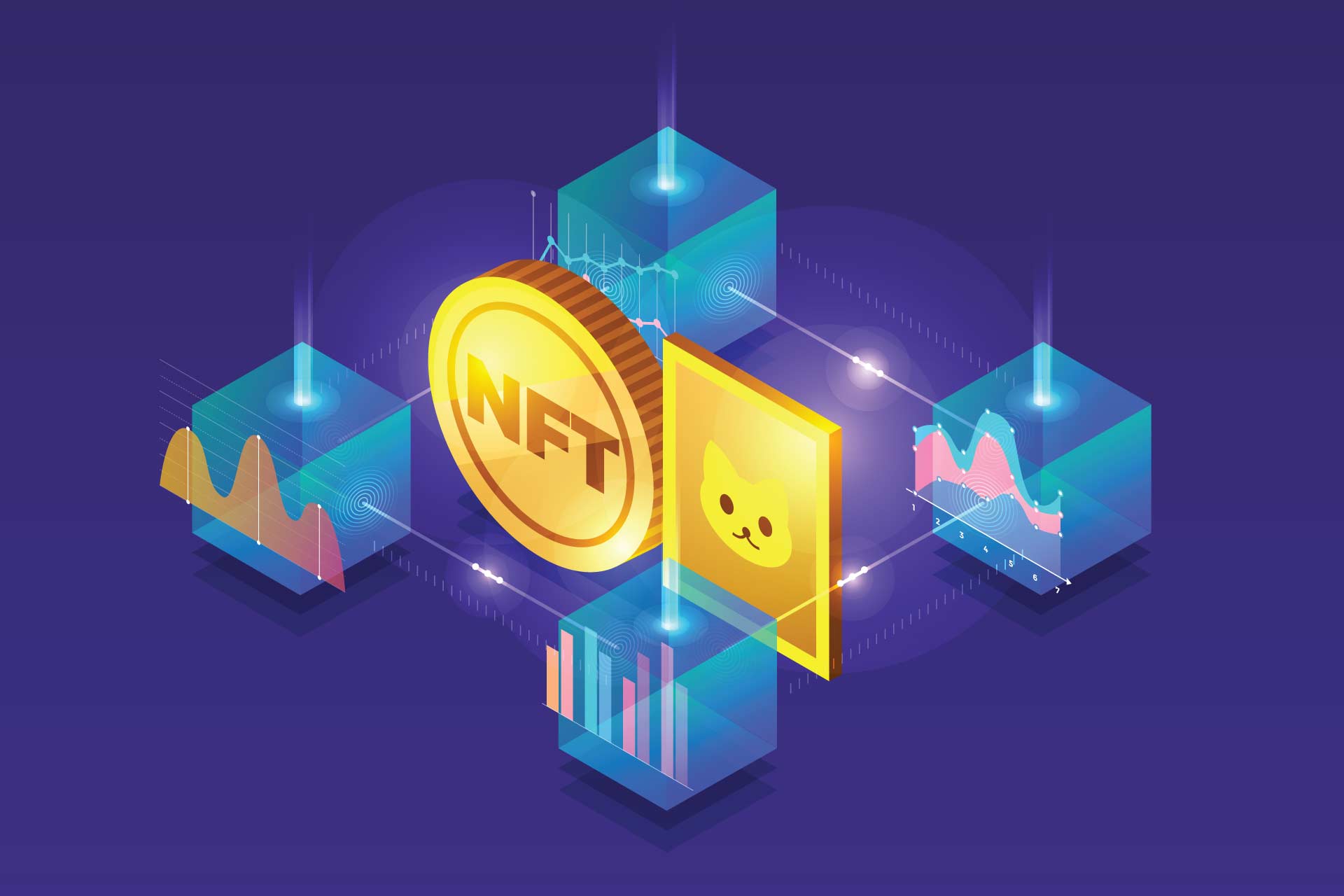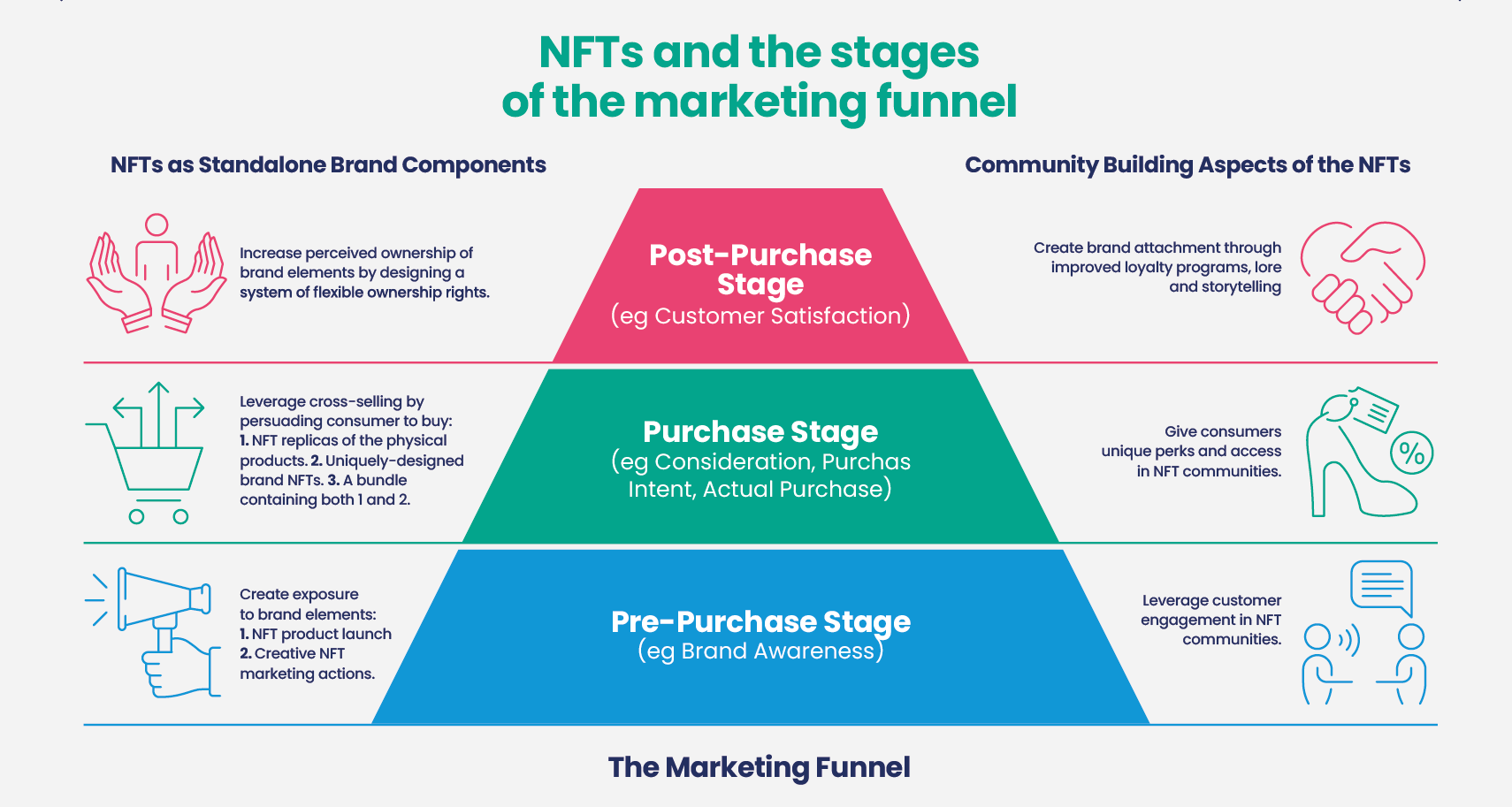
Professor Anatoli Colicev discusses the opportunities Non-Fungible Tokens (NFTs) offer brands to reach and engage consumers at different stages of the marketing funnel.
With whopping sales of more than £13.5 billion in 2021, NFTs have come a long way since the early days of CryptoPunks and cryptokitties, as the market has evolved into more than just an opportunity to monetise digital art and collectives.
The importance of NFTs is expected to increase with the development of Web3, and innovative and forward thinking brands have started to unlock the potential of NFTs to enhance their story telling strategies, generating buzz and connecting with consumers in exciting new ways.
From a conservative perspective, NFTs can be seen as representations of brand components, such as the product (eg a digital twin of a physical product), the logo or the image.
However, in his paper How can non-fungible tokens bring value to brands, Anatoli argues NFTs have immense potential to become standalone brand assets that contribute to the overall brand equity.
This is because NFTs open up new opportunities to achieve two key objectives at the pre-purchase, purchase and post-purchase levels: serving as brand products and fostering brand communities.
By relating NFT strategies to the marketing funnel stages, Anatoli explores how brands can leverage NFTs to target consumers at different steps of the decision-making process, from increasing brand awareness, to encouraging purchases and enhancing after-sale satisfaction.

The marketing funnel, or purchase funnel, describes the sequential customer decision-making that occurs in several stages: pre-purchase, purchase and post-purchase. Brands design tailor-made marketing strategies appropriate for each stage to encourage the development of customer-brand relationships, before and after the sale is completed.
Reaching new audiences and leveraging the power of NFT brand communities
The NFT hype cycle is fuelled by cryptocurrency enthusiasts, Gen-Z Discord users and a more technologically oriented crowd.
An NFT product launch can be used as a catalyst to generate brand awareness among these previously unreachable audiences, and Anatoli suggests collaborations with established NFT collections can enhance the PR potential of NFT launches further.
What are NFTs and why do people buy them?
When a digital asset, for example an image, is turned into an NFT, it is uploaded to the blockchain infrastructure to be “certified” as a unique photo which receives a specific digital signature that no other version will ever have.
This is called tokenisation: the NFT is attached to a digital certificate of ownership, and therefore it can be purchased, sold, and traded.
However, unlike other tokenised digital assets that can be divided and exchanged for something similar or equal in value (eg Bitcoin), NFTs are non-fungible or interchangeable, meaning they are singular and unique.
Each NFT is one of a kind, with no equivalent, as many of the world’s most valuable assets, such as rare gems, antiques or original masterpieces like the Mona Lisa.
The rarity and exclusivity of NFTs is what makes them attractive as an investment to then sell in the secondary market for profit, or pleasure, as is the case of serious collectors of unique artwork or cool digital assets.
Another incentive to buy NFTs is that ownership provides access to special perks, including utility, community benefits, merchandise, etc.
In summary, NFTs are the digital answer to valuable collectibles, under the premise that if non-digital assets can sell for millions, digital assets can achieve that too.
Typically, the NFT market is organised in collections of digital assets released by an artist, or group of artists, with a limited number of individual NFTs that conform to the same artistic style, with slight variations across each individual token.
Reputable collections such as the Bored Ape Yacht Club (BAYC) or World of Women, have entry prices of tens of thousands of dollars on OpenSea, the largest marketplace for NFTs.
Hence, NFT collaborations with established collections hold exceptional potential to expose the brand, and trigger conversations among an already captivated audience.
NFT enthusiasts often gather in highly engaging, decentralised and anonymous social media platforms, including Discord, Telegram or Reddit, which allows conversations to flow more organically, almost emulating real-life connections and friendships.
These NFT communities can be utilised as an amplifier for a brand’s marketing efforts in the pre-purchase stage of the marketing funnel and beyond.
For example, TIME Magazine’s TIMEPieces project is a Web3 community initiative that brings together artists, collectors and fans, offering NFT collections of artworks inspired by actual pictures from the magazine.
TIMEpieces NFT holders receive subscription rights, exclusive invitations to events and art drops, with established and emerging artists.
The project utilises its Discord community of over 8,000 subscribers and Twitter channel, to fuel conversations and hype, as well as enabling engagement by hosting daily games, challenges and even private rooms for NFT holders, which facilitates exposing the brand to Gen-Z readers.
Increased loyalty via NFT ownership and online/offline bundles
NFT products from reputable brands allow consumers to digitally "flex" their purchases online, for example with pieces of virtual clothing or accessories used to dress-up avatars in a virtual world, known as with NFT wearables.
However, brands can increase the value of these purchases by persuading consumers to buy bundles of NFTs and physical products that provide access to a combination of unique symbolic and functional benefits.
The Nike-RTKFT Cryptokicks iRL is a collection of co-branded customisable digital sneakers, inspired by the Nike Mag shoe, from the movie Back to the Future II.
In late 2022, Nike announced the selling of 19,000 bundles of digital and physical Cryptokicks iRLs, and gave Nike Trillium Lace Engine NFT* holders priority access to purchase four limited editions of the iconic trainers.
Alongside giving access to exclusive physical products, early drops, merchandise or premium services, bundles open up opportunities for cross-selling, for example via gamified experiences where consumers earn tokens redeemable for discounts for physical products.
In terms of community brand building, NFT ownership can be used as the key to membership programmes that provide extra perks, invitations to private events, or access to locked channels in Discord for people who have purchased an NFT, a physical product or both.
For example, in 2021 the BAYC NFT community organised a private yacht party in New York with famous basketball players, artists, musicians and investors, for owners of the exorbitantly priced digital cartoon monkeys (at least £160K on OpenSea).
In addition, several restaurants use NFTs for reservations that prioritise seating, while concerts can issue tickets as NFTs to give extra benefits to holders.
Influencing post-purchase consumer experiences
Although consumers generally display the lowest sensitivity to marketing stimuli in the post-purchase stage of the funnel, Anatoli argues NFTs can help brands create stronger consumer involvement and brand attachment.
Compared to traditional legal approaches, where copyright belongs to the original creator(s), NFTs allow a flexible design of ownership rights.
For instance, BAYC NFT owners have the right to use their NFTs on digital fashion (eg 10KTF), books (eg Jenkins the Valet) or even movie characters.
By owning the rights to such NFTs, consumers might develop stronger perceived ownership of certain brand elements, which can increase closeness and encourage them to serve as ambassadors or shareholders.
However, Anatoli points out the critical challenge for brands consists of deciding the optimum trade-off between releasing copyrights and protecting the brand owner.
From a community building perspective, companies can enhance post-purchase experiences by creating authentic and creative storytelling around the brand’s identity, via stories, lore, and characters with which consumers can connect.
For example, the Adam Bomb Squad (ABS) is an NFT project inspired by The Hundreds streetwear brand’s mascot, an anthropomorphic bomb called Adam.
Later ABS NFT collections featured new characters, such as Adam’s love interest, Madam Bomb, or his alter ego, Badam, with existing NFT holders being given preferential access to sales and free NFT airdrops**.
Similar strategies can be applied to different chapters of a book or story, and physical aspects can also be incorporated into brand loyalty programmes, for example via physical merchandising or treasure hunts in real life for QR codes.
Plenty of opportunities, but an uncertain future
Despite the potential for marketers, Anatoli stresses NFTs are still in their infancy, and the lack of regulatory frameworks mean important challenges are looming for the NFT market, including decentralisation, design of ownership rights and mining’s environmental impact.
In addition, from a user perspective, buying NFTs requires a certain level of financial literacy, such as understanding the basics of cryptocurrency and Web3 wallets.
On the bright side, brands have the potential to benefit from the first-mover advantage and are on the right side of history.
*The Nike Trillium Lace Engine NFT is a digital asset resembling the virtual engine that powers the Cryptokicks auto-lacing and fit technology.
**An NFT airdrop is a distribution of free NFTs large number of crypto wallets, often used as a marketing strategy to promote new tokens or reward existing NFT owners.
 |
Chair in Marketing, Strategy and Analytics |
|
You can read Anatoli's paper here: Colicev, A. (2023). ‘How can non-fungible tokens bring value to brands’, International Journal of Research in Marketing, 40(1):30-37
|